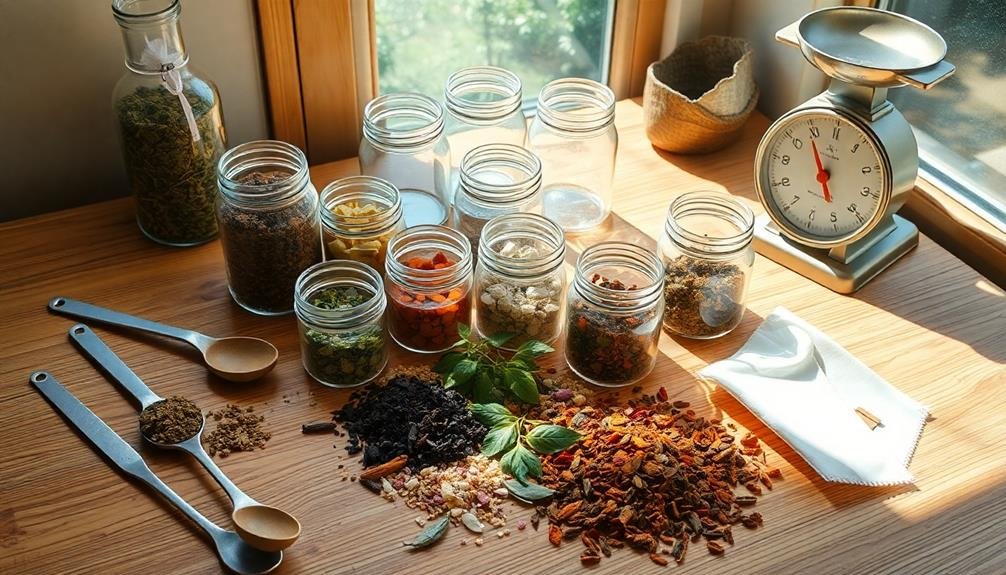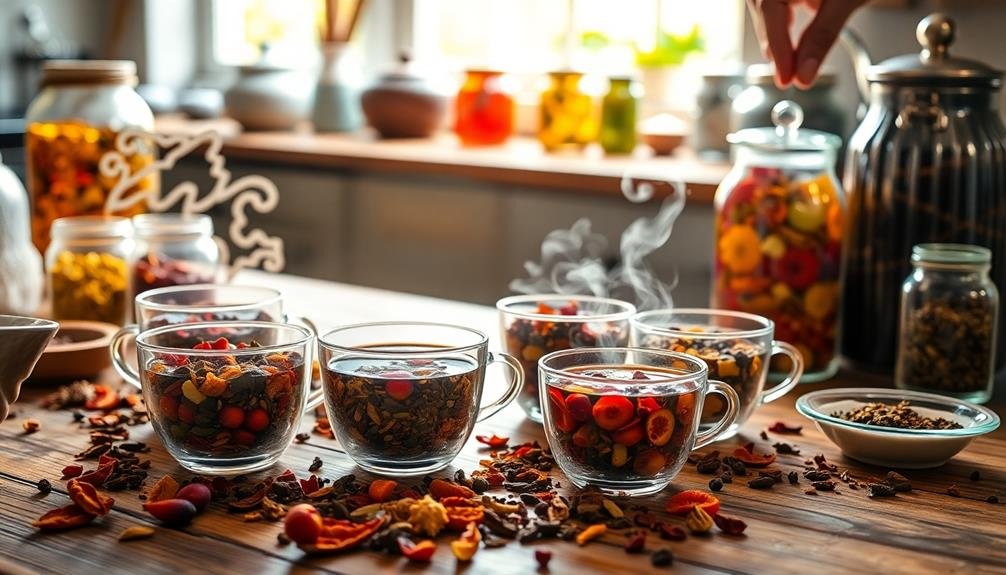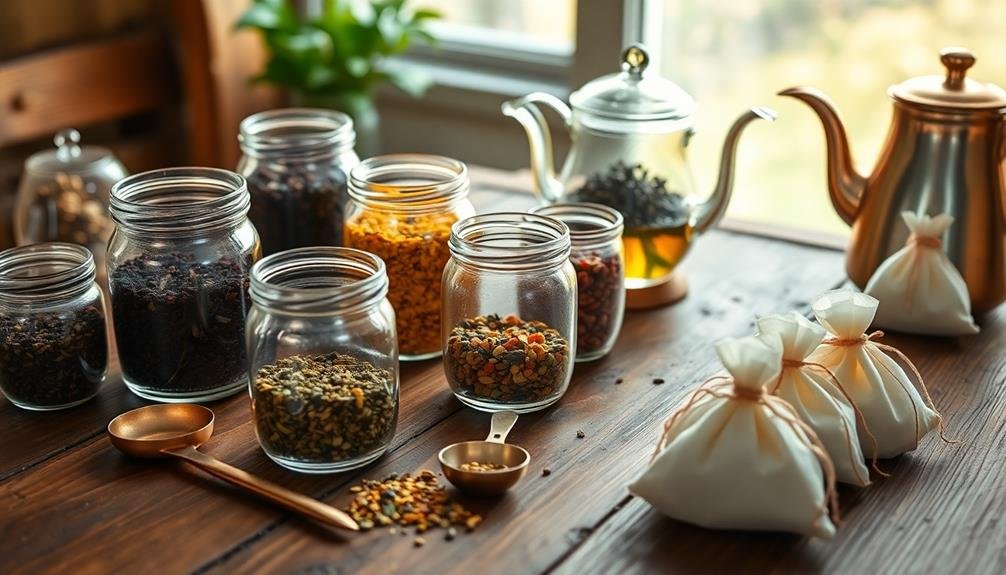Transform into a tea artisan by hosting your own tea blending workshop. Gather essential supplies like base teas, herbs, spices, and dried fruits. Set up a comfortable, well-lit space with all the necessary tools. Guide participants through the blending process, teaching them about flavor profiles and combinations. Encourage creativity as they measure and mix ingredients to create unique blends. Show them how to craft custom tea bags and design attractive labels for their creations. You'll create a memorable experience that allows everyone to explore the art of tea blending. Dive deeper to reveal the full potential of your tea-blending adventure.
Gathering Essential Tea Blending Supplies

Excitement builds as you prepare to begin your tea blending journey. To start, you'll need to gather essential supplies.
Begin with a selection of base teas, including black, green, white, and oolong varieties. These form the foundation of your blends. Next, collect a range of herbs, spices, and dried fruits to add flavor and complexity. Popular choices include chamomile, peppermint, cinnamon, ginger, and dried berries.
You'll also need tools for measuring and blending. Invest in a set of digital scales for precise measurements, along with mixing bowls and spoons. Don't forget storage containers to keep your creations fresh. Label makers or tags are useful for identifying your blends.
For tasting purposes, acquire a variable temperature kettle, allowing you to brew different teas at their best temperatures. Stock up on tasting cups, infusers, and a timer to guarantee consistent brewing.
Lastly, consider providing notebooks and pens for participants to record their recipes and tasting notes. With these supplies at hand, you're ready to start your tea blending adventure, creating unique and personalized blends that reflect your taste preferences.
Selecting Base Teas and Herbs
As you begin selecting base teas and herbs, it's crucial to understand their unique characteristics and flavor profiles. Start with classic base teas like black, green, oolong, and white teas. Each offers a distinct taste and aroma that'll serve as the foundation for your blends.
For black teas, consider robust options like Assam or Ceylon for a strong, malty flavor. Green teas like Sencha or Gunpowder provide a lighter, grassier base. Oolong teas offer a middle ground with their partially oxidized leaves, while white teas bring a delicate, subtle flavor.
When choosing herbs, think about their complementary flavors and potential health benefits. Chamomile adds a soothing, floral note, while peppermint offers a revitalizing kick. Lavender can provide a calming aroma, and rosehip contributes a tart, fruity element.
Don't forget about spices like cinnamon, ginger, or cardamom, which can add warmth and depth to your blends. Dried fruits such as apple, orange peel, or berries can introduce natural sweetness and vibrant flavors.
Experiment with different combinations to create unique and personalized tea blends.
Creating Flavor Profiles and Combinations

With your base teas and herbs selected, it's time to explore the art of creating unique flavor profiles and combinations. Start by considering the characteristics of each ingredient and how they might complement or contrast with one another.
Think about balance – you'll want to avoid overpowering flavors while ensuring each component contributes to the overall taste.
Experiment with different ratios of ingredients to find the perfect blend. Begin with small batches, mixing just a teaspoon or two of each component. Take notes on your combinations, including the proportions used and your impressions of the resulting flavor.
Don't be afraid to mix unexpected elements. Pair floral notes with citrus, or combine earthy tones with sweet fruits.
Consider the mouthfeel of your blend – do you want it smooth, bold, or invigorating? Add spices for warmth or mint for coolness.
Remember that some flavors develop over time, so steep your blends for various durations to discover their full potential. Taste test frequently and adjust as needed.
You'll soon develop a knack for predicting how different ingredients will interact, allowing you to create truly unique and delicious tea blends.
Measuring and Mixing Ingredients
Precision is key when measuring and mixing ingredients for your tea blends. You'll need a reliable kitchen scale to weigh your ingredients accurately. Start with small quantities, typically 10-20 grams total for each blend. This allows you to experiment without wasting too much tea.
Begin with your base tea, which usually makes up 60-80% of the blend. Add flavoring ingredients like herbs, spices, or dried fruits in smaller proportions. Use teaspoons for larger ingredients and pinches for finer ones.
Mix your blend in a clean, dry bowl using your hands or a wooden spoon. Be gentle to avoid crushing delicate tea leaves.
For consistency, record the exact measurements of each ingredient. This guarantees you can replicate successful blends later. If you're adding essential oils or flavoring extracts, use droppers for precise control. Start with just a drop or two, as these are potent.
Once mixed, let your blend rest for a day or two. This allows the flavors to meld and settle.
After resting, brew a small sample to taste and adjust as needed. Remember, you can always add more of an ingredient, but you can't take it away.
Crafting Custom Tea Bags

Once you've perfected your tea blend, it's time to package it for convenient use. Crafting custom tea bags allows you to enjoy your creation easily and share it with others.
Start by selecting the right materials: choose between biodegradable filters or reusable muslin bags, depending on your preference and environmental concerns.
For disposable bags, use a tea bag sealer or iron to seal three sides of the filter. Fill each bag with 1-2 teaspoons of your blend, then seal the final edge. If using muslin bags, simply fill and tie them securely with cotton string.
Consider adding personalized touches to your tea bags. Create custom labels with the blend's name, ingredients, and steeping instructions. You can also add decorative elements like dried flowers or colorful tags. For an extra special touch, dip the string in essential oils that complement your blend's flavors.
Store your custom tea bags in an airtight container to preserve freshness. If giving as gifts, package them in decorative tins or boxes.
Remember to include brewing instructions and any special notes about your unique blend to enhance the recipient's experience.
Labeling and Packaging Your Blends
Proper labeling and packaging are the final steps in presenting your tea blends professionally. Choose attractive containers that preserve your tea's freshness and showcase its beauty. Glass jars, tin canisters, or resealable pouches are excellent options. Design eye-catching labels that include the blend's name, ingredients, and steeping instructions.
When creating your labels, consider these key elements:
| Element | Purpose | Example |
|---|---|---|
| Blend Name | Captures attention | "Sunset Serenity" |
| Ingredients | Informs customers | "Green tea, chamomile, lavender" |
| Steeping Time | Guarantees ideal flavor | "Steep for 3-5 minutes" |
Don't forget to include your brand name and contact information on the packaging. If you're selling your blends, add required details like net weight and any allergen warnings. Consider using eco-friendly materials to appeal to environmentally conscious customers.
For a professional touch, invest in a label maker or high-quality stickers. If you're feeling creative, hand-write labels for a personal touch. Remember, your packaging is the first thing customers see, so make it reflect the care you've put into your blends.
Setting Up Your Workshop Space

When setting up your tea blending workshop space, you'll need to choose the right location that's spacious and well-ventilated.
Make sure you've prepared all the essential equipment, including scales, containers, and tea samples.
Create an inviting atmosphere with proper lighting, comfortable seating, and perhaps some soothing background music to enhance the overall experience.
Choose the Right Location
Selecting the perfect location for your tea blending workshop is essential for creating an enjoyable and productive experience. Consider spaces that offer ample room for participants to move around comfortably and work with tea ingredients.
Look for a well-ventilated area to prevent overwhelming scents from lingering and interfering with the blending process. Prioritize locations with good natural lighting, as it'll help participants accurately assess the colors and textures of different tea leaves and ingredients.
Guarantee the space has sufficient electrical outlets for any equipment you'll need, such as electric kettles or blenders. If possible, choose a location with a sink or easy access to water for brewing and cleaning.
Consider the ambiance of the space as well. A calm, serene environment will enhance the tea blending experience and allow participants to focus on their creations.
If you're hosting the workshop at home, clear out a spacious area in your kitchen or dining room. Alternatively, look into renting a community center, tea shop, or culinary school kitchen for a more professional setting.
Prepare Essential Equipment
Once you've secured the ideal location, it's time to gather and set up the necessary equipment for your tea blending workshop. Start by acquiring a variety of tea leaves, herbs, and spices for blending.
You'll need scales for precise measurements, mixing bowls, and small containers for participants to store their creations. Don't forget to provide spoons, tea filters, and labels for the finished blends.
Set up your workspace with cleanliness in mind. Cover tables with clean tablecloths and provide hand sanitizer for participants.
Arrange your ingredients in an organized manner, making sure everything is easily accessible. Place electric kettles or hot water dispensers strategically around the room for brewing samples.
To create an engaging atmosphere, consider incorporating these elements:
- A display of tea-related books and magazines for inspiration
- A tasting station with pre-brewed samples of popular blends
- A mood board showcasing different tea flavors and their pairings
Lastly, prepare handouts with basic tea blending guidelines, flavor profiles, and safety precautions.
Create Inviting Atmosphere
Along with proper equipment and organization, creating an inviting atmosphere is essential for a successful tea blending workshop.
Start by selecting a well-lit, spacious area that allows participants to move freely. Guarantee there's ample natural light or use warm, soft lighting to create a cozy ambiance.
Set up comfortable seating arrangements, preferably around a large table or in small clusters. This encourages interaction and collaboration among participants.
Add some greenery with potted herbs or plants to bring a fresh, natural element to the space.
Play soft, soothing background music to enhance the relaxing atmosphere. Consider using instrumental tracks or nature sounds that won't distract from the tea-blending process.
Display tea-related artwork, books, or decorative teaware to spark inspiration and conversation.
Use aromatic diffusers with calming scents like lavender or chamomile to engage participants' senses.
Provide each attendee with a personalized welcome kit, including a name tag, tasting notebook, and pen. This thoughtful touch will make them feel valued and prepared for the workshop.
Guiding Participants Through Blending Process
Guide participants through the tea blending process with clear, step-by-step instructions. Start by explaining the basics of tea blending, including the importance of balance and complementary flavors.
Demonstrate how to measure and mix different tea bases, herbs, and flavorings. Encourage participants to smell and taste individual ingredients before combining them.
Next, provide a selection of base teas, herbs, spices, and dried fruits for participants to experiment with. Offer guidance on popular flavor combinations, but also encourage creativity.
As they blend, remind them to take notes on their recipes for future reference.
To keep your workshop engaging and informative, incorporate these elements:
- Blind taste tests of various tea blends
- A mini-lesson on the health benefits of different ingredients
- A friendly competition for the most innovative blend
As participants create their unique blends, circulate the room to offer advice and answer questions. Encourage them to sample each other's creations and share feedback.
Conclude the workshop by having everyone package their favorite blend to take home, complete with a personalized label.
Frequently Asked Questions
How Long Does a Tea Blend Typically Stay Fresh?
Your tea blend's freshness typically lasts 6-12 months when stored properly. You'll get the best flavor if you consume it within 3-6 months. Keep it in an airtight container away from light, heat, and moisture to extend its life.
Can I Use Artificial Flavors in My Tea Blends?
You can use artificial flavors in your tea blends, but it's not recommended. They often lack the depth and complexity of natural ingredients. Instead, opt for high-quality dried fruits, herbs, and spices to create unique, flavorful blends you'll love.
Are There Any Tea Combinations That Should Be Avoided?
You should avoid combining strongly flavored teas that clash, like mint with smoky Lapsang Souchong. Don't mix delicate teas with overpowering ones. It's best to steer clear of blending caffeinated and herbal teas, as they have different steeping times.
What's the Best Way to Store Large Quantities of Tea?
Store your tea in airtight containers away from light, heat, and moisture. You'll want to keep it in a cool, dark place. Don't mix different teas in the same container. Use glass or ceramic for best results.
How Can I Calculate the Caffeine Content of My Custom Blends?
You can't precisely calculate caffeine in custom blends without lab testing. However, you can estimate by knowing the caffeine content of each tea type used and their proportions in your blend. It's an inexact science, but it'll give you a rough idea.
In Summary
You've now got all the tools to host an amazing tea blending workshop. Share your passion for crafting unique flavors with friends and family. Don't be afraid to experiment and let your creativity shine. Remember, there's no right or wrong in tea blending—it's all about personal taste. Encourage your participants to trust their instincts and have fun. With practice, you'll all become tea blending experts in no time!





Leave a Reply